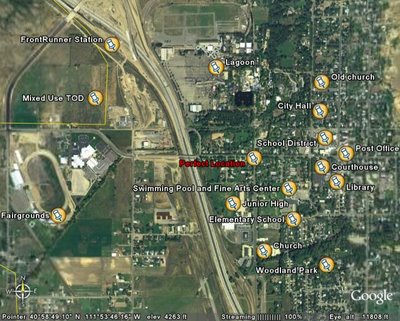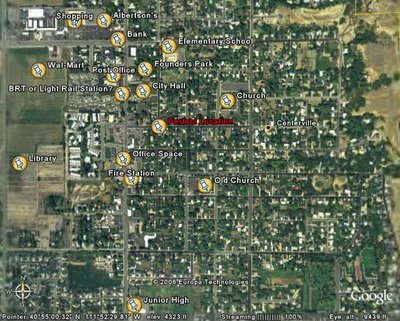
(click on the image for a clearer version)
This location couldn't be better as far as mass transit goes. If you walk two blocks east, you can get on the 55 and the 70. These are the two most essential bus routes in Davis County that will get you many places. If one route doesn't work well for when and where you need to go, then the other one probably will. For instance, it's faster to take the 55 to Ogden, but if you need to go to Clearfield, you take the 70. The 55 will take you to Fruit Heights, east Layton, South Weber, South Ogden, WSU, the U of U, and anywhere along 4th East/Orchard Drive in Centerville, Bountiful and North Salt Lake. The 70 will take you through the downtowns of SLC, Bountiful, Centerville, Kaysville, Clearfield, Sunset, Riverton and Ogden, but the 70 is much, much slower than the 55.
But most importantly, this location is close to a proposed FrontRunner station, which will get you to downtown Ogden and SLC faster than any bus will.
If you have children in school, this is a good location, because the junior high and the elementary school are just two blocks away. Evidently, the Davis County School District has a site for a Farmington high school by the fairgrounds, but I don't know exactly where. If it really is right by the fairgrounds (kitty corner maybe?), then that's within pretty reasonable walking distance too. Even if you don't have kids, it's nice to live near schools because many events are held at them.
As far as proximity to government/civic buildings go, this location is excellent. From here, you can walk to the library, the courthouse, city hall, the school district's office buildings, the post office, the City's public works building, the County's health and human services building and the firehouse (the latter three aren't shown on the above image).
If you're LDS, you can walk to church. It's a little farther away, but you could also walk to the fairgrounds (how often do you have to go to the fairgrounds anyway?). If you bank at Wells Fargo, you can walk there too.
If aesthetics are important to you, then this is also a good place. The immediate neighborhood has plenty of historic homes, and mature sycamore trees line the streets.
And just a couple blocks away are Farmington's swimming pool and arts center, and it's just a little farther to Woodland Park. You could also walk to Lagoon (although I don't think it's worth paying
$33.95 for a day pass).
But there's one big downside.
There are no shopping places within reasonable walking distance, except for a floral shop, a pizza place, a sandwich shop, and that's about it. And most dissapointing, there's no grocery store now that Bowman's is gone.
On the bright side, there will be commercial development adjacent to the new FrontRunner station. But there might not be a grocery store there. We'll see.
So this location gets an "A" for aesthetics, mass transit, and proximity to public places. But it gets an "F" for proximity to commercial establishments.


